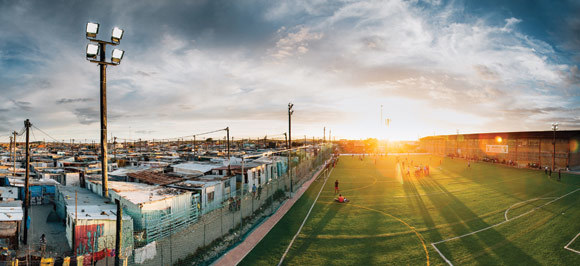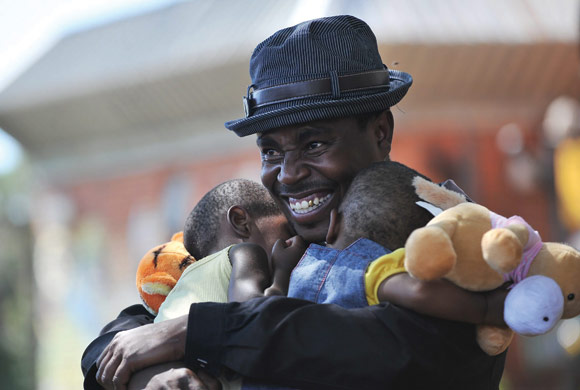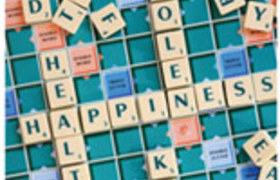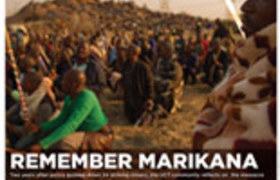Child Gauge 2014
01 December 2014
The only way to end the cycle of violence is to prevent it
The mainstream media in South Africa has no shortage of stories about violence perpetrated against children. These cases, extreme enough to be covered by reporters, are just the tip of the iceberg: over half of South Africa's children frequently experience some form of violence from a very early age, and our system – under-resourced and over-burdened – is tasked with responding to these incidents.
But, while the knee-jerk reaction to such horror in the media is a normal human response, and those tasked with taking on each case might see no end in sight, the Children's Institute at the University of Cape Town is asking the most important question of all in their Child Gauge 2014: how can we prevent violence against children, rather than reacting to it?
Where are we?
While many acknowledge that levels of violence against children are unacceptably high in South Africa, a veil is drawn over the exact nature and extent of the problem. This paucity of research and data presents a major stumbling block.
According to Associate Professor Shanaaz Mathews, director of the Children's Institute, "South Africa is both lacking national empirical data on the exact magnitude of the problem, and has a limited research base on the causes and effects of violence against children in the local context."
The data that is available, however, exposes the underbelly of the problem.
It is through lack of prevention that we end up with the horrifying statistics at hand, and even just a snapshot of some of them paints the fullness of the picture: a conservative estimate of 26 000 child victims were in the crime stats of 2011-2012; in 2009, 1 018 children were murdered, and 45% of these murders occurred in the context of child abuse, while incidents of sexual violence (which are known to be under-reported) amounted to nearly 22 781 in the 2013-14 crime statistics.
That is an average of 62 cases per day.
And that's the bigger picture.
In the life of an individual, different forms of violence are more prevalent at different stages. UNICEF's Patrizia Benvenuti, who co-authored a chapter with Mathews in the Child Gauge 2014, explains: "It is important to understand how violence impacts on children's psycho-social functioning at different developmental stages."
She says this perspective also "highlights how early experiences of violence may increase the risk of children becoming victims or perpetrators later in life, and how the cumulative effect of violence has negative outcomes for the child in later life".
The agenda, however, can be set with one overarching goal in mind: better surveillance systems, which would strengthen protection mechanisms.
To this end, a national study on violence against children is currently under way, and this research will provide the first national prevalence estimates by 2015.
Effective prevention: is our country ready?
According to Joan van Niekerk of Childline South Africa, "Most countries follow a response-driven approach to the prevention of child maltreatment", even though "mitigating the consequences of violence for [the] affected child is unlikely to decrease the incidence of violence against children in the population as a whole."
This is also an expensive approach.
The costs of prevention programming are a fraction of the treatment costs and are estimated to result in a saving of 96 to 98%.
But the lack of prevention programming in South Africa is not because the legal frameworks are absent.
As Van Niekerk points out, "South Africa has put in place laws and policies that support the prevention of violence against children, but implementation has been slow."
She and Mokhantso Makoae of the Human Sciences Research Council say that most child protection programmes, with the exception of social grants, are implemented by NGOs in the social welfare sector; and that historically, these organisations have focused on the provision of early-intervention and tertiary-response services.
"Any shift in practice will depend on the capacity and readiness of South Africa to implement prevention programmes," they say.
An international study by the World Health Organisation found that South Africa has low levels of readiness for programming of this nature, but Van Niekerk and Makoae recommend a multi-sectoral approach to implementing the National Strategic Plan; stronger surveillance systems to identify families and children at risk; broad-based prevention that changes behaviours associated with risk; and strong co-operation between government, professionals, civil society and researchers to create programming that fosters community ownership and participation.
Adopting a systems approach
Stakeholders with an interest in the well-being of children are asking the same question: Why is there a significant gap between the state's legislative and policy commitments, and the real-life experiences of children?
Despite our well-meaning laws and policies, says Cathy Chames of Southern Hemisphere, "South Africa's children continue to experience violence in a range of settings, including the home, school, community, alternative care, and the justice system."
That said, the law itself could do with fine-tuning, say the researchers.
Chames and colleague Dena Lomofsky explain that the Domestic Violence Act, Sexual Offences Act, and Child Justice Act present "a key design problem", in that these laws were developed separately, and therefore do not speak to one another – and sometimes contradict each other.
They recommend reviewing the legislation with the goal of 'harmonising' it.
Another buzzword for what is needed is 'collaboration' – across government departments (with the Department of Social Development at the helm) and across all role-players within society, including but not limited to civil society, the media, schools, and religious and traditional leaders.
This could lead to holistic programming that breaks the 'vicious cycle' wherein social workers spend more time responding to situations than delivering early intervention services.
Parenting skills development, therapeutic programmes and managing family disputes are some of the areas in which money and energy could be better expended.
Also, say the authors, local data is paramount.
"Programmes and services should be planned and targeted according to local needs. So the more local-level the data, the better. The international trend in child protection surveillance is to use data to understand child maltreatment at a neighbourhood level," they say.
Are we adequately resourced?
The answer to this question, in a word, is 'no'.
Adequate financial and human resources are both fundamental to the prevention of child maltreatment.
Yet, according to Lucy Jamieson of the Children's Institute, in 2013 more than two-thirds of role-players cited 'lack of material resources' as a major challenge.
To compound this, it is not possible to track or even estimate expenditure on prevention interventions because the funding is "scattered across a number of sub-programmes in the provincial budgets".
The budget for 2014-15 is less than half of a predicted 'low-cost scenario', and only 7% of a predicted 'high-cost scenario'.
Other challenges cited by Jamieson, Lorenzo Wakefield (from the Consortium on Crime and Violence Prevention) and independent researcher Megan Briede are that funding is not being prioritised for children with disabilities, and that funding for NPOs has declined steadily since 1994, and is also not appropriately allocated.
In terms of human resources, too, there is a dire shortage of skilled professionals working in prevention. For example, many early childhood development outreach workers have no formal training, while less than a third of child and youth care workers are adequately trained.
On the positive side, an illuminating role model is the Isibindi programme, which, explain the authors, "delivers services to vulnerable children in communities (mostly in remote rural areas) with high HIV and AIDS prevalence rates, unemployment and poverty, and few existing social services."
It is based on a model of care that sees community-based programmes training unemployed community members in accredited, integrated child and youth care services.
But it is the exception to the rule.
The authors call for much higher investment in resources for prevention and early detection services, for NPOs to be remunerated at full cost for their services in this arena, and for the development of a far stronger workforce of professionals to carry out the necessary work.
 Sonke Gender Justice helps to challenge gender inequality, and promotes men's involvement as fathers. Photo supplied by Sonke Gender Justice.
Sonke Gender Justice helps to challenge gender inequality, and promotes men's involvement as fathers. Photo supplied by Sonke Gender Justice.
Behind closed doors
Children's psycho-social and cognitive development is adversely affected in the long term by physical abuse and corporal punishment.
Because of this, early interventions with young children are essential for the long-term health of individuals and society; and it is also crucial that support is given to parents and caregivers.
Children below the age of five are the most reliant on their caregivers, yet interventions are notoriously difficult to get right, as "most physical abuse and corporal punishment in the early years occur in the child's home", explains Andrew Dawes from UCT's Department of Psychology.
And, he adds, "It is complicated by religious and cultural justifications. These have their roots in the deeply patriarchal and conservative attitudes held by many in South Africa."
Primary targets for intervention include vulnerable families and caregivers, and pre- and ante-natal women in particular. Home visits from well-trained community nurses, mental-health screenings for mothers during pregnancy, and a greater understanding of the role of men in childcare are vital to enhancing the capacity of caregivers. Examples of successful programmes to this end include the Philani Plus home-visiting programme, and the Perinatal Mental Health Programme run by UCT; but more are needed.
Corporal punishment is another area where clear and demonstrable long-term negative effects on development have been recorded, yet it remains prevalent and notoriously difficult to monitor.
In one Eastern Cape study it was found that 89% of women and 94% of men had experienced corporal punishment by caregivers before the age of 18.
While there might be difficulties implementing a prohibition on corporal punishment in the home, many activist groups (such as NGO Sonke Gender Justice) feel it is an important stepping stone, as are effective parenting programmes.
Starting school: an increased risk of violence
As children begin their life as school learners, they are out of the home and in the wider community much more frequently.
When they venture out, they face an increased risk of violence – in particular, sexual violence, which has a lifetime impact on physical and mental health, brain functioning, life expectancy, employment and sexual health.
Lucie Cluver and Franziska Meinck of Oxford University, along with Shaheeda Omar of the Teddy Bear Clinic, advise that there are also risks of secondary trauma when "health and justice services are unable to cope with the needs of sexually abused children", and that the "attitudes of justice and court officials are crucial to reducing secondary trauma for the child".
A best-practice model in prevention of sexual abuse is evident in the Zero Tolerance Village Alliance in rural Limpopo. It has shown encouraging results by using a multi-pronged intervention that includes workshops on sexual rights, police training in victim empowerment, and the establishment of village committees, safe houses and support groups for victims.

Adolescents and violence
The high prevalence of violence creates the perception that violence is normal, particularly as "hegemonic masculinity is the dominant cultural form" in South Africa, say Pinky Mahlangu and Anik Gevers of the Medical Research Council.
In the adolescent age group, the roles of victim and perpetrator are both common, and in vulnerable, poverty-stricken communities, "success and respect are often earned and defended through violent behaviour towards the more vulnerable in society", they say, adding that "this is further compounded by the failure in the criminal justice system to convict offenders".
Yet there are signs of hope.
The Children's Institute's Ariane de Lannoy says that schools offer a particularly effective strategy for reaching large numbers of young people, and these programmes have the ability to reach beyond individuals and into the wider community of peers, parents and teachers.
The Stepping Stones programme, for example, runs a series of 13 peer-facilitated workshops to create a participatory environment for sharing and growth with positive results. 'Prepare' uses the school environment for an adolescent HIV-prevention programme, while Amandla EduFootball goes broader, as a community-based intervention for both in-school and out-of-school youth, leaders and organisations.
"Higher levels of risk are encountered as young adults move further away from home and family in search of connection with peers," explain Mahlangu and Gevers.
While the structural causes and problems remain the same, an increased degree of risk-taking behaviour creates increased exposure to violence. That risky behaviour manifests in different ways for boys and girls.
According to the researchers, "Males have been found to show externalising risk-taking behaviour such as truanting, involvement in crime and substance abuse, while girls are more likely to display internalising behaviour such as depression, anxiety and suicidal thoughts."
On the other hand, interventions are easier to manage and maintain in this age group, and there are a significant number of programmes showing encouraging results.
Making it work
With the Children's Act as a roadmap for South Africa, the framework is in place to deliver a systematic, multi-sectoral approach, but the ability to shift from policy to practice requires a number of steps for effective implementation, say Mastoera Sadan and Shanaaz Mathews of the Children's Institute.
Firstly, a common understanding of prevention and "identifying existing strengths and building the resilience of children and their families through collaboration with other service providers" is important.
Secondly, what is needed is a coherent policy framework "that includes both secondary and tertiary prevention". Evidence is critically lacking across all sectors, and "it is critical that administrative data sources be streamlined and managed effectively", say Sadan and Mathews.
The report concludes that "prevention programmes should not be viewed in isolation, but rather integrated across government departments, primary healthcare and early childhood services, and into a national strategy that can make a difference in the lives of South Africa's children".
 This work is licensed under a Creative Commons Attribution-NoDerivatives 4.0 International License.
This work is licensed under a Creative Commons Attribution-NoDerivatives 4.0 International License.
Please view the republishing articles page for more information.
News
Feature
Front page
Focus
Photo Essay
Faculty Focus - Science
Previous Editions










